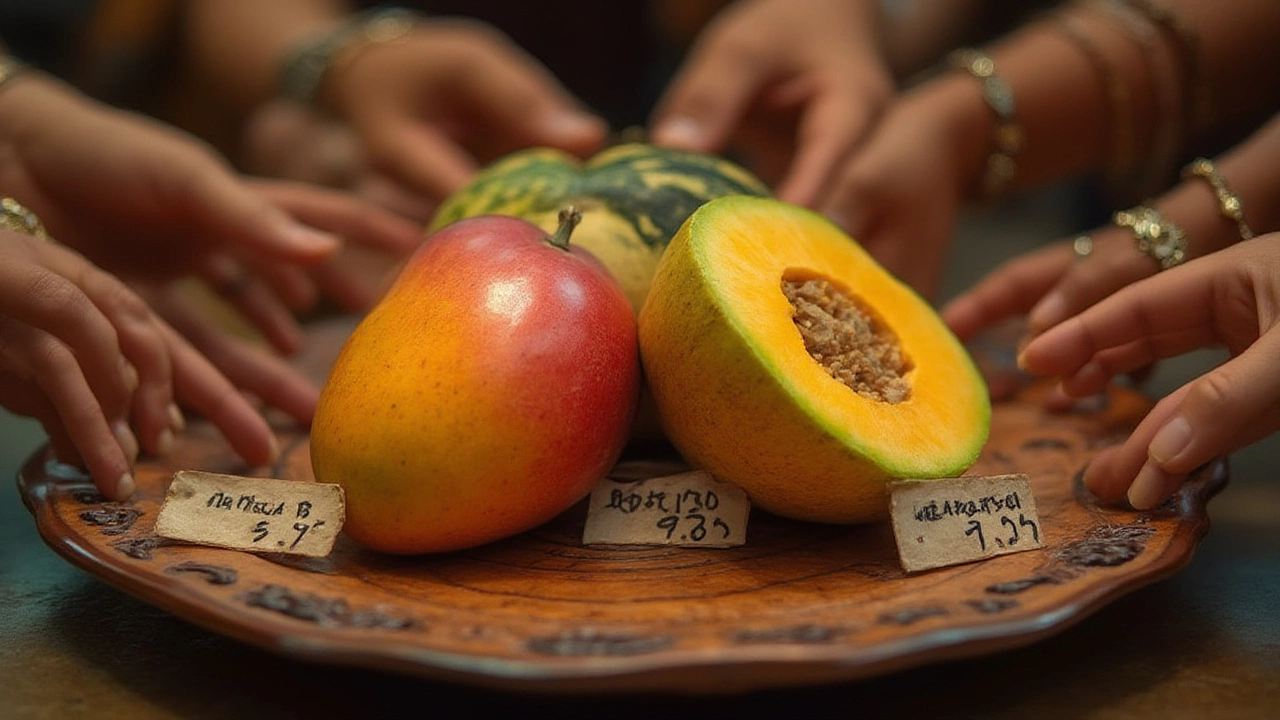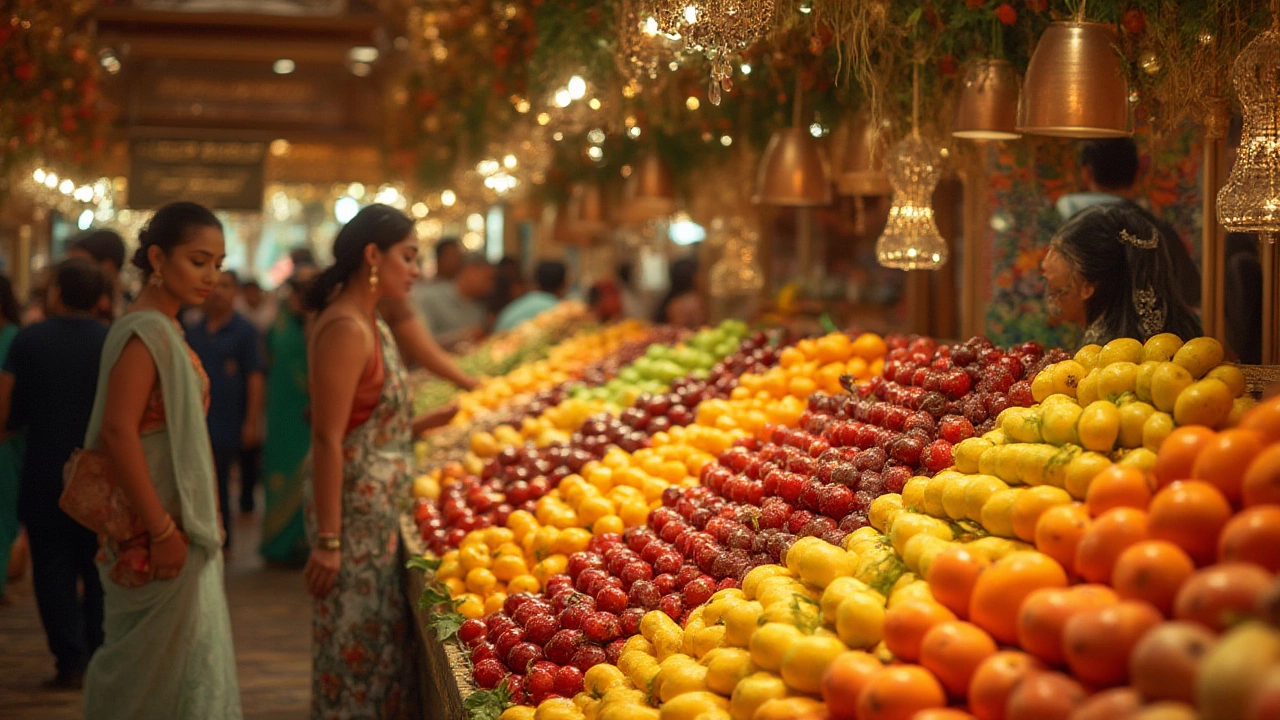You think apples and mangoes top the scale at Indian fruit stalls? Put that thought on hold. There are fruits in India that can cost you more than a fancy dinner for two, sometimes even more than the latest smartphone. Why do people pay through the nose for something they’ll munch down in minutes? The answer is part status, part rarity, and sometimes just pure madness for good taste. Some fruits carry price tags that don’t seem real—until you see someone buying a single bunch for lakhs. Let’s unravel what makes these fruits so expensive, and why people still crave them.
What Makes a Fruit the Costliest in India?
Price isn’t just about taste. Several reasons come together to push the price of a fruit through the roof. Take climate sensitivity. Some luxury fruits like Japanese Ruby Roman grapes or Miyazaki mangoes need perfect weather and constant pampering. If a farmer in India even tries to grow them, every step—right from soil testing to hand-pollination—requires precision. That’s a lot of labor, and the costs add up fast. Then, think about exclusivity. When something’s rare, people start craving it more simply because not everyone can get it. The law of supply and demand isn’t just a textbook phrase; it’s what makes these fruits officially “luxury.”
Also, don’t ignore the bling factor. Some of these fruits—like the Miyazaki—are protected in netted bags to keep their shape, color, and shine. Farmers polish and nurture each fruit as if it’s jewelry. Every bit of care and extra effort means a hike in the price label. Even transport costs drive up the final figure. When you’re shipping a precious cargo like rare melons or imported grapes, you throw in insurance, careful packaging, and sometimes even armed guards! It sounds wild, but stories about fruit heists have become legend in places where specialty harvesting attracts attention. That sense of drama adds to their appeal—and their price.
If you peek at history, rare fruits were often exchanged as royal gifts. This isn’t just old stories—right now, gifting exclusive fruit boxes is how Indian business tycoons and celebrities show off wealth and taste. Presentation plays a role too. Special fruits often get encased in velvet-lined boxes, each piece handpicked and inspected for perfection. So, next time you see a ₹2 lakh mango gift box on Instagram, know someone is deliberately paying that extra for bragging rights.
The Costliest Fruits: More Than Just Pricey Mangoes
When people talk about the costliest fruit in India, one name trumps the rest: the Miyazaki mango. Sometimes called the “Egg of the Sun,” this flaming red mango can fetch anywhere between ₹2.5 lakh to ₹3 lakh per kilogram at auction. The mango first showed up in Miyazaki, Japan, but a few Indian farmers in Madhya Pradesh have started cultivating it with imported saplings. Harvest is tiny—sometimes just a dozen mangoes a year—making each piece a trophy. There are break-ins reported around Miyazaki mango farms, proving just how crazy the scramble can get.
Not far behind is the Jade Buddha grape, known as “Ruby Roman” in Japan. A single bunch once sold for ₹8.6 lakh (about $11,000 at the time). Some Indian importers bring these grapes in specially chilled containers. As you can imagine, most supermarkets never even see them. They go straight to luxury hotels or directly to A-list buyers.
Yubari King Melon—the designer fruit of Japan—also makes occasional appearances in Indian wedding gift baskets. A pair sold at an auction in Japan for close to ₹20 lakh, although imported melons usually cost less here due to transport restrictions and import duties. Still, at ₹50,000 to ₹2 lakh a melon in India, it’s a jaw-dropper at any fruit bazaar.
| Fruit | Average Price per kg/piece in India | Origin |
|---|---|---|
| Miyazaki Mango | ₹2–3 lakh/kg | Japan/India |
| Ruby Roman Grape | ₹60,000–8 lakh/bunch | Japan |
| Yubari King Melon | ₹50,000–2 lakh/melon | Japan |
| Densuke Watermelon | ₹30,000–60,000/piece | Japan |
| Australian Finger Lime | ₹8,000–15,000/kg | Australia/India |
But costliest doesn’t always mean imported. The Noorjahan mango from Madhya Pradesh can weigh over 3 kg and regularly sells for ₹2,500– ₹3,000 a piece. Gir Kesar mangoes from Gujarat and Alphonso from Ratnagiri touch dizzying prices during the first flush of the season, thanks to a battle of status among buyers who want the “first box.” When word gets out that a particular orchard has fruited again after a gap of years, people travel for miles for just one taste.
Behind the High Price Tags
The journey from farm to table for these fruits is nothing like a regular apple or banana. Some high-priced varieties, like the Densuke watermelon, need perfectly controlled climates. Even a bit too hot or too rainy, and the crop fails. Most rare fruits don’t have disease resistance that common produce enjoys. So, a farmer can gamble a whole year just to get a dozen fruit worth selling.
Farming methods get downright geeky. For luxury mangoes like Miyazaki, every blossom is carefully pollinated by hand, and the fruit grows wrapped in mesh nets and sometimes even cloth bags. They water them with measured, filtered water. Pesticide and fertilizer usage is logged and monitored—if a batch fails a chemical residue test, the entire harvest becomes worthless. For Ruby Roman grapes, every grape is checked for color and sugar level with a refractometer. If even one grape in the bunch fails the test, that bunch is not auctioned.
Transport adds another layer. Most of these fruits are flown in cooled aircraft cabins and packed with humidity sensors. Just to bring a few dozen Ruby Roman grapes from Japan to India, buyers pay for custom handling, insurance, and sometimes personal couriers. For fruits like Yubari King Melon, they’re hand-packed in foam, with the stalks carefully trimmed and straightened.
Why pay so much? For one, these fruits often sell at fundraising auctions, especially the very first harvested pieces of the season. Winning that auction is about status and publicity, not just eating. Also, luxury hotels, celebrity chefs, and influencers want to impress—with pictures, of course. There’s a whole side business in “rare fruit influencers” sending tasting notes and unboxing videos for their wealthy followers.

Where To Find These Fruits – If You’re Up For It
Don’t expect to spot these luxury fruits at the local bazaar the next time you step out. Most costliest fruits are found through high-end importers, super exclusive food markets, five-star hotel chains, or direct auctions. In cities like Mumbai, Delhi, and Bengaluru, upscale grocery stores sometimes do flash sales of rare items, but they’re gone within hours, and sometimes pre-ordered by regular buyers.
Here’s a tip: wedding season and big Indian festivals are when luxury fruit baskets surface the most. This is when businesses order in advance, and gift shops display their “exclusive” hampers. If you want a rare Noorjahan or a chance at a Miyazaki, you’ll need to contact specialty farms or their agents months before the harvest is due. Some farms even have VIP waiting lists of loyal buyers who get the “first bite” every season. Online delivery? Only possible for some imported or less fragile items, never for fruits like Yubari Melon or Ruby Roman grapes, which require babying from farm to buyer’s table and can’t handle careless shipping.
Collectors and foodies sometimes travel across states or even fly overseas to visit special fruit auctions. It’s a new kind of “fruit tourism” that’s growing every year. In 2024, a top-end grocery chain in Delhi set a local record after auctioning a single box of Ruby Roman grapes for ₹7 lakh, drawing national headlines. Expect similar stories every few months once you join these exclusive fruit circles.
Tips For Experiencing the Luxury Fruit Scene
If you’re determined to taste the costliest fruit in India without torching your bank account for a selfie, here’s some advice. First, timing is everything. The opening weeks of the mango, grape, or melon season are when prices peak due to hype, media coverage, and demand from tycoons who want bragging rights. But if you can wait till the end of the season, prices usually drop as supply gets a last-minute bump. Sometimes, farmers sell “B grade” fruit at a fraction of the cost—these look a little less pretty but taste just as good.
Join specialist food groups or forums—there are hundreds of WhatsApp and Telegram groups where enthusiasts share tips, auction info, and direct deals with trusted farmers. Some buyers form clubs to split the cost, making a luxury fruit tasting session affordable for everyone. If you’re lucky, you get to attend a blind tasting where you can compare Alphonso, Noorjahan, and even imported grapes without any markup from fancy stores.
Don’t forget, some rare varieties are now being trial-grown in India. Over the last five years, select farms in Maharashtra, Andhra Pradesh, and Madhya Pradesh have experimented with luxury Japanese mango and grape seedlings. They don’t always match import quality, but you still get 80% of the experience at a much lower cost. Ask around for local growers—it’s not just tastier but supports Indian farming innovation.
The luxury fruit world isn’t just about eating. There’s an entire science to fruit judging, auctions, packaging, and even record-keeping. Watch out for India Book of Records or Limca Book of Records—whenever someone grows a giant mango or an ultra-rare grape, you’ll read about it. Want to impress guests? Show up with a Noorjahan mango at your next party and you’ll see people lining up for a taste, phones out, Instagram stories ready.
And if you want to just window-shop, most high-end fruit stores are happy to let customers admire their most expensive displays—just don’t try handling them without permission!
Why Are People Still Obsessed With Expensive Fruits?
There’s something wild about humans chasing after the costliest fruit in India. Some do it for sheer curiosity—what makes a lakh-rupee mango so special compared to one from a regular market? Others treat it as a status symbol, especially when gifting or entertaining. Filmmakers, influencers, and businessmen all use rare fruit tastings as a talking point in parties and posts. Food scientists get involved too, always trying to breed new hybrids that might one day fetch a fortune.
There are stories of luxury mangoes being protected round the clock by guard dogs, grape farms installing CCTV to deter thieves, and celebrities competing to post the first picture of an imported melon on social media. Costs are also driven by these viral moments—the more buzz, the higher the auction price goes. It’s not about nutrition or hunger; it’s about that moment when you have something nobody else can—even for a few hours.
If you’ve ever bitten into a perfectly ripened Alphonso, you know taste can make even a regular fruit unforgettable. Now, if you add rarity, perfect breeding, insane presentation, and a dash of drama, you get a showstopper that’s as much an event as it is a treat. Not everyone agrees with shelling out lakhs for a bunch of grapes or a mango the size of a football, but those who do are chasing a slice of something very few get to try.
Want to know what drives these fruit obsessions? It’s FOMO at its ripest! You’ll see stories of business lobbies reserving melons for “good luck” or families sending custom mango crates worth family holidays to each other. Even if the price sometimes seems silly, the stories, competition, and pure thrill will keep luxury fruits as Indian conversation starters. Who knows, you might be one step away from eating a tiny piece of sunshine—if luck and your wallet allow it.
